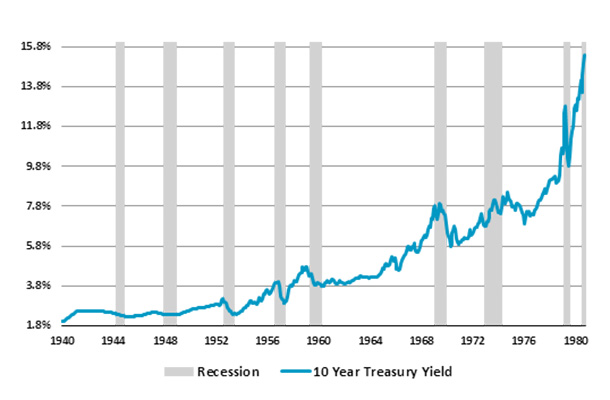by John Zidle, Investment Strategist, Blackstone
The Great Bond Bull Market is Over June 2016 will most likely be remembered as the end of the great bond bull market. 34 years earlier in 1982, when then Fed Chair Paul Volker turned the full force of the Federal Reserve to fighting inflation, both the 10 year Treasury yield and the Consumer Price Index (CPI) stood at approximately 15%. Over the ensuing years investors experienced the biggest bull market in history. The Bloomberg Barclays Agg Bond Index returned an average of 8.4% annually. Over that time the economy experienced booms and busts, but the near constants were falling rates and slowing inflation.
From Deflation to Inflation The economy is accelerating and inflationary pressures are picking up. Not yet strong, they are broad based. This past week’s unemployment numbers (3.8%) and wage gains (+2.7%) are confirmation of the trend that has been building for 2 years. Other forms of inflation are emerging including higher oil and gas prices, and more subtly is the current trade spat which could increase the price of imports.
The key question What will be the impact on fixed income holdings? Using the last 34 years as a guide, one would have little reason to worry about secularly higher rates. Experience argues the economy will roll over, the Fed will reduce interest rates and bond prices will rally (yields will fall). Using that logic, one would argue that the 10 year treasury can’t sustain itself very long at these yields. It will soon revert to 1.5%-2.0%.
A very dangerous assumption Very few people have invested in an environment of structurally higher yields. Prior to 1982, there was a 40 year bear market in which the yield on the 10 year went from 1.97% to 15%. Over that time the US experienced 9 recessions. The chart below highlights the trend: 10 year treasury yields came down during recessions but would very quickly rebound. Over this period, bond total returns failed to keep pace with inflation, returning an average of 2.4%, well below the 5.6% for the Consumer Price Index.
10 Year Treasury Yield & Recessions: 1940-1982

The data has changed, portfolios haven’t Since June 2016 data from the Investment Company Institute (ICI) indicates that investors have added over $560 billion to taxable fixed income mutual funds and ETFs. An analysis of the largest inflows indicates that investors are taking more duration risk, maybe even unintentionally as the underlying durations of the indices for many fixed income ETFs increased. For example, the duration of the Bloomberg Barclays Agg Bond Index moved from 4.4 years in 2016 to 6.3 years (as of 5/2018). The biggest risk to investors is not recognizing that the data changed. History proves bond yields do move higher.
Copyright © Blackstone















